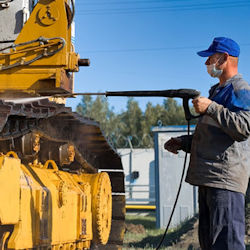Exercise
It's time to take what you've learned so far and apply it by analyzing the facts of an actual accident that occurred a few years ago (names have been changed). In answering the questions, we'll uncover weaknesses in the employer's hazard communication program and identify issues with overall safety leadership. Read through the scenario below and answer the questions.
Findings: Severe Hydrofluoric Acid Burns at XYZ Power Wash
- XYZ Power Wash uses diluted hydrofluoric acid (HF), a clear, colorless liquid with mild detergent odor, to wash industrial vehicles with a mobile pressurized cleaning system. The company has seven employees. In cleaning operations, the company mainly uses diluted HF (0.1%) at all their operations. However, a few contracts require the use of concentrated HF (4 - 10%) to provide better brightening of aluminum truck parts.
- The victim, Mr. Jones, stated he sustained severe chemical burns on his hands during a powerwash operation in the pit area at Jupiter Equipment Company while preparing to clean heavy equipment. Jupiter Transport did not want Mr. Jones to use the XYZ concentration, but rather their own concentration at 10% HF.
- While filling a garden sprayer with the 10% HF, Mr. Jones accidentally splashed it on his gloves and forearms. Mr. Jones stated that, since he did not feel any pain or stinging, he did not worry about getting his hands wet.
- According to Mr. Jones, later that evening, his hand and forearm began to ache. The pain eventually became so intense that he went to the local hospital emergency room where he received immediate treatment for HF burns. However, due to the delayed treatment, he suffered severe damage to tissue and the bones of his hand. (Flourosis of the bone occurs when fluorine ions replace calcium in the bone.) As a result, part of his hand had to be amputated.
- Mr. Smith, the employer, stated that Mr. Jones had received training on the safe handling of HF and was informed to wear gloves when working with the concentrated HF. However, he states that Mr. Jones was not wearing gloves when the accident occurred. No written documentation of training could be located.
- Mr. Smith provided a statement by Mr. Bill, of Jupiter Transport stating he observed the above incident and warned Mr. Jones to wear gloves while handling HF.
- Mr. Jones stated that he had never been provided hazard communication training on this or any other chemical used by XYZ, and he denied having spoken to Mr. Bill at the time of his accident.
- Employee interviews substantiate Mr. Jones' claim that hazard communication training was not being accomplished. There were no Safety Data Sheets (SDS) available at either XYZ or Jupiter. Additionally, there were no eye wash stations or shower facilities near the area where employees handle 10% hydrofluoric acid (HF).
Knowledge Check Choose the best answer for the question.
2-7. Which finding strongly indicates that the victim did NOT receive adequate safety training?
You forgot to answer the question!

